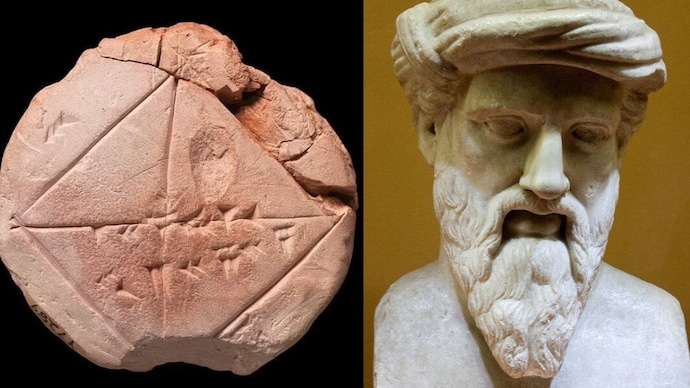
Pythagoras did not discover famed theorem! Babylonian tablet unearths plagiarism
Is the Pythagorean theorem the world's oldest known case of plagiarism? Recent findings reveal an ancient Babylonian tablet with principles predating the Greek philosopher by over 1,000 years.

While the Greek philosopher Pythagoras, born in 570 BC, has long been accredited with creating the mathematical concept that determines the missing side of a right-angled triangle, fresh evidence appears to debunk this.
An ancient Babylonian tablet displaying a concept predating Pythagoras by over a millennium suggests the Pythagorean theorem could be the world's oldest known case of plagiarism.
YBC 7289: THE CLAY TABLET OF DISCOVERY
The revelation comes from translating an ancient Babylonian clay tablet, designated as YBC 7289, dating back to 1800-1600 BC.
Bruce Ratner, a mathematician with a PhD in Mathematical Statistics and Probability from Rutgers University, unearthed this revelation.
Ratner recently examined the ancient Babylonian tablet that employs the principles of the Pythagorean theorem to calculate the length of a rectangle's diagonal, thus indicating that the theorem was in circulation much before Pythagoras's era.
PYTHAGORAS: POPULISER NOT PIONEER
While Pythagoras is credited with popularising the theorem, the existence of the Babylonian tablet suggests that the mathematical concept predated his birth by centuries.
It is conceivable that Pythagoras may have encountered the theorem through oral tradition and contributed to its dissemination.
Legend has it that Pythagoras conceived his theorem while observing stone square tiles in a palace hall. By discerning right triangles within the tiling, he deduced that the sum of the squares of the side lengths equaled the square of the hypotenuse.
Further examination reveals that the ancient Babylonians were familiar with the mathematical relationship encapsulated by the Pythagorean theorem, albeit not recognised under that name. This celebrated equation is also known as Euclid I 47, among other designations.
UNVEILING THE BABYLONIAN TABLET'S SECRETS
Mathematician Bruce Ratner, in his research, asserts, "The Pythagorean Theorem was discovered and proven by Babylonian mathematicians 1000 years before Pythagoras was born."
Ratner's study focuses on the YBC 7289 tablet, found in southern Mesopotamia and housed at Yale University.
By interpreting the markings on the tablet within the context of the Babylonians' base-60 counting system, Ratner unearthed their profound understanding of the Pythagorean theorem and other advanced mathematical concepts.
The Babylonians' knowledge of the square root of two, a number recognised as irrational, suggests an understanding of the Pythagorean theorem, particularly its special case for square diagonals.
This revelation challenges conventional wisdom about the origin of this theorem and highlights the scarcity of original Pythagorean sources due to reliance on oral transmission.
THE INHERITANCE OF KNOWLEDGE
Pythagoras's contributions were likely attributed to him as a mark of respect and reverence, leading to the term 'Pythagoras' Theorem.' This underscores the role of Pythagoras as a populariser of mathematical knowledge rather than its original creator.
